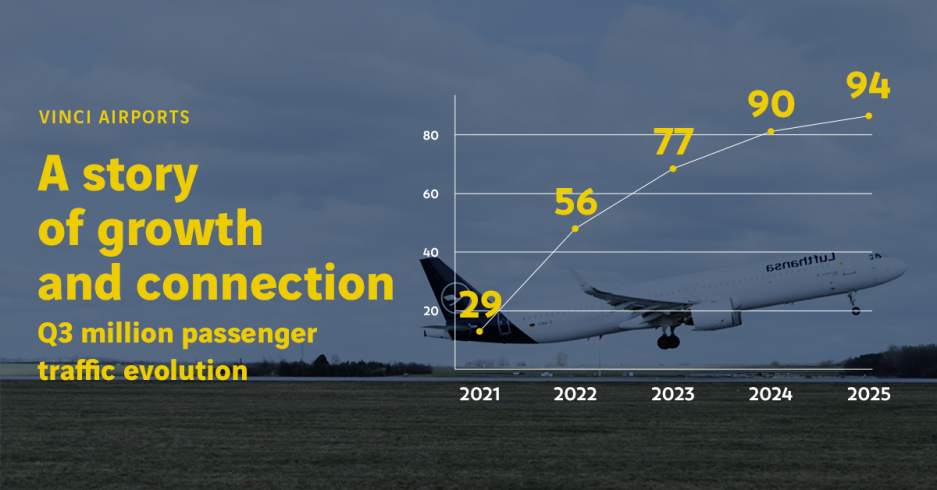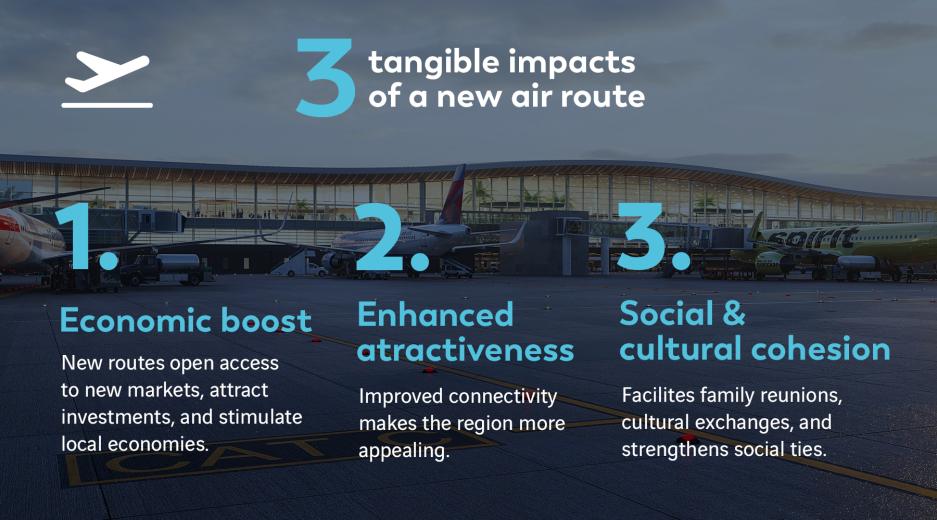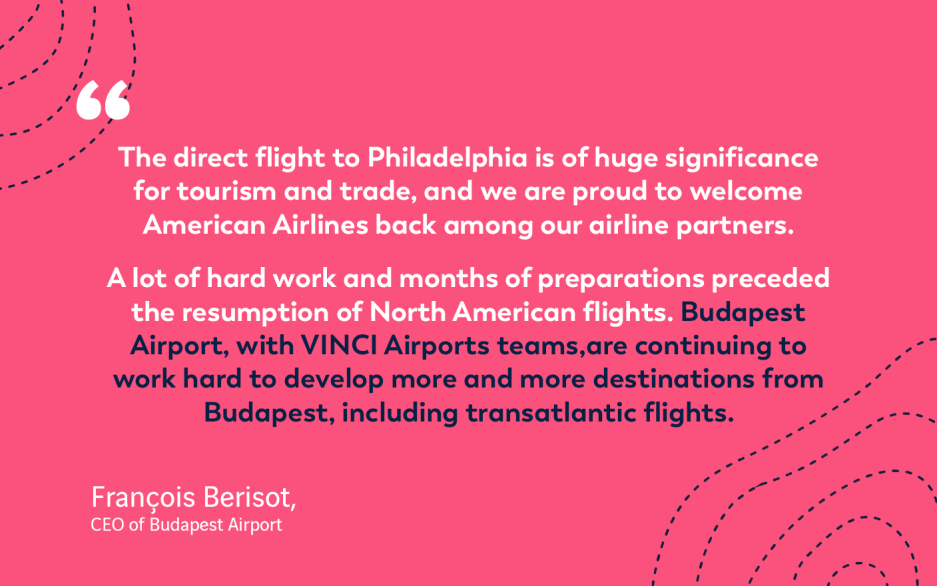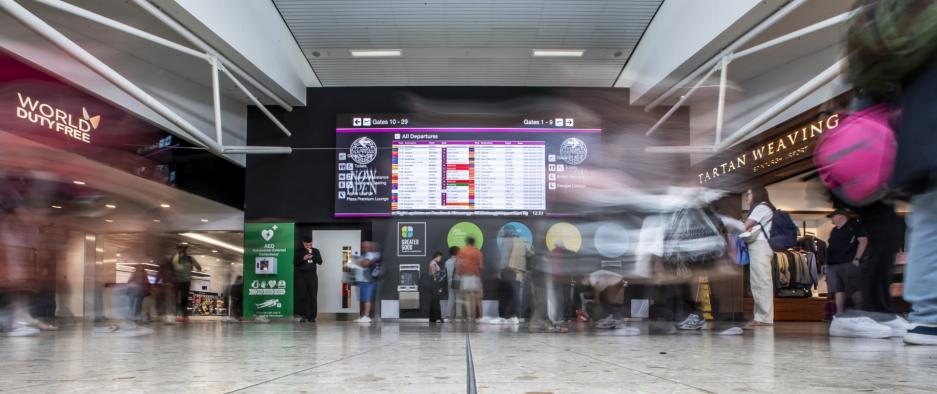
Positive Mobility
eMagTerritorial connectivity strengthened by rising air traffic across VINCI Airports network
A growth dynamic, yes. And above all, a dynamic of connections. Behind the 4.2% cumulative growth in passenger traffic during the second quarter of 2025 compared to the previous year - representing 3.8 million additional passengers across VINCI Airports and new destinations served - are families reuniting, businesses expanding their reach, and territories opening up. And one certainty grows stronger: air mobility doesn't just connect places: it connects territories and their inhabitants.

When a new route opens new perspectives
On one side, Lisbon. On the other, Los Angeles. Between them, a direct route by TAP Air Portugal - three flights a week that erase a continent and open new transatlantic opportunities. Further north, Edinburgh now links directly to Montreal with Air Canada, while also stepping up its connections to New York and Boston. At London Gatwick, Uganda Airlines has launched flights to Entebbe, strengthening ties with East Africa. And in Lyon, Tassili Airlines now connects twice weekly to Algiers, a bridge between France and the Maghreb. In France, Nantes and Lyon airports recorded good traffic in August. In Nantes, French, Spanish and Italian tourist destinations were very popular (increased service from easyJet and Air France Group airlines). In Lyon, French and North African destinations performed well.
Within the VINCI Airports network, new synergies are also taking shape: Funchal now links to Edinburgh, Lisbon to Santo Domingo, London Gatwick to Santo Domingo - weaving a tighter web between our platforms.
These routes aren’t chosen at random. They answer precise needs - business, family, leisure - and redraw the map of connectivity: more direct, more relevant, more valuable.

Creating value for territories
A new route isn't just a new flight; it's a new chapter of development. Access to new markets, strengthened tourism, increased attractiveness for talent: the effects of good connectivity are measured in tangible returns.
For example: +12% in Cabo Verde, +11% across Japan’s Kansai Airports, +10% in Cambodia, +9.2% in Brazil, and +7.2% at Budapest airport (Hungary). Monterrey (Mexico) also maintained strong growth at +15%, confirming its strategic role in North America. These solid results illustrate how targeted air connections generate measurable business impact and strengthen the competitive position of VINCI Airports’ major hubs.
Airports in the VINCI Airports network actively contribute to territorial connectivity in line with local economic priorities. Their role today goes beyond acting as transport hubs: they enhance overall accessibility, stimulate investment, and support the growth ambitions of residents, businesses, and public stakeholders.

Vital connections, far beyond leisure
In certain island or isolated territories, air travel plays a role that goes beyond tourism. It's an accessibility lever, sometimes essential to daily life. In Brazil, for example, domestic routes such as Manaus–Porto Velho are crucial for connecting remote communities, supporting supply chains, and ensuring the delivery of essential goods. In Japan, air links between regional airports strengthen cohesion across the archipelago, providing faster access to healthcare, administration, and economic hubs.
Ground and air infrastructures complement each other to meet territorial needs. Each flight strengthens this network while reminding us that an airport's utility is also measured by its ability to reinforce social bonds.

VFR, Business, Tourism: the new face of 2025 traffic
And the travelers? They're definitely there, but with new profiles. Business travelers, first. They stand out for their regularity and more targeted needs. Their presence on long-haul flights contributes to the stability of strategic routes.
VFR flows (Visiting Friends and Relatives) also continue their growth, particularly between Europe, Africa, and overseas territories. They represent a significant portion of traffic, often flying under the radar, but essential. They tell stories of diasporas, cultural ties, and family solidarity.
Finally, leisure passengers remain a key driver. Some destinations, such as Budapest, Osaka, or Madeira (Portugal), show marked growth in the second quarter. Others, like Edinburgh or Lisbon, benefit from promising new connections that strengthen their position in tourist flows.

Summer peak: the art of operational agility
Facing the summer surge, platforms operated by VINCI Airports are adjusting their systems: staff reinforcements, increased coordination with airlines, and data-driven anticipation tools. The goal: absorb peak periods without compromising service quality.
This operational agility is central. It guarantees smooth journeys, even during high-traffic periods. And transforms the airport experience into a loyalty driver.
Innovating for passengers and territories
An airport is no longer just an arrival or departure point. It's a testing ground, an innovation catalyst. Through their development projects, platforms operated by VINCI Airports are becoming living laboratories where new ways to improve mobility, accessibility, and local integration are tested.
These platforms coordinate around a common innovation strategy based on three pillars: intelligent infrastructure, passenger experience, and flow management. To achieve this, three airports serve as centers of excellence for the VINCI Airports network, and beyond, for VINCI Concessions entities:
London Gatwick, dedicated to airport operations and development, seeking to improve capacity and performance through innovation.
Lyon, dedicated to enhancing the overall passenger travel experience, aiming to better meet their needs and expectations.
Lisbon, specializing in smart terminals to streamline flows.
Partnerships with universities, open innovation, full-scale experiments: ideas circulate as fast as planes. The objective: anticipate users' real needs and develop solutions beneficial to territories.
An entire value chain is set in motion: from startups and internally-driven projects finding practical applications, to communities benefiting from concrete outcomes. The airport thus becomes a lever for territorial transformation in its most tangible form.
And tomorrow? Weak signals becoming strong trends
Refined segmentation, increasingly personalized journeys, multiplication of point-to-point connections: air transport is being reshaped. Hubs are fading, flows are regionalizing. The introduction of biometrics, AI, and contextualized services accelerates the transformation.
VINCI Airports anticipates this evolution by co-creating with territories and airlines. And places the user at the heart of its innovations.

Connecting people, not just cities
Q2 2025 traffic results are positive: +6.7% overall traffic growth, with particularly marked increases, notably in Budapest, Monterrey, and Phnom Penh, confirming their exceptional dynamism. But beyond the numbers, these results tell a story: one of useful, chosen, anchored mobility.
In Lisbon, Lyon, Monterrey, or London Gatwick, airports in the VINCI Airports network are anchored in their territory. They aren't just departure points: they support local dynamics, enhance economic attractiveness, and facilitate everyday mobility. Perhaps that's the true performance today: successfully connecting people to the places that matter.